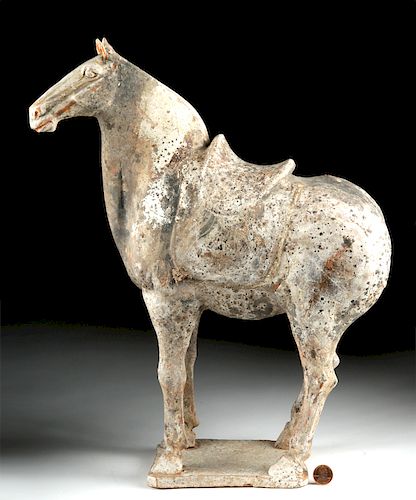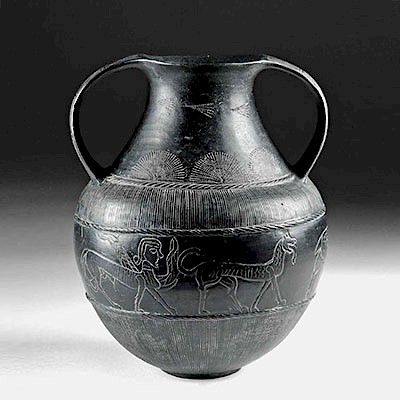Chinese Han Dynasty Terracotta Horse - TL Tested
Lot 130a
About Seller
Artemis Gallery
686 S Taylor Ave, Ste 106
Louisville, CO 80027
United States
Selling antiquities, ancient and ethnographic art online since 1993, Artemis Gallery specializes in Classical Antiquities (Egyptian, Greek, Roman, Near Eastern), Asian, Pre-Columbian, African / Tribal / Oceanographic art. Our extensive inventory includes pottery, stone, metal, wood, glass and textil...Read more
Categories
Estimate:
$3,000 - $5,000
Absentee vs Live bid
Two ways to bid:
- Leave a max absentee bid and the platform will bid on your behalf up to your maximum bid during the live auction.
- Bid live during the auction and your bids will be submitted real-time to the auctioneer.
Bid Increments
| Price | Bid Increment |
|---|---|
| $0 | $25 |
| $300 | $50 |
| $1,000 | $100 |
| $2,000 | $250 |
| $5,000 | $500 |
| $10,000 | $1,000 |
| $20,000 | $2,500 |
| $50,000 | $5,000 |
| $100,000 | $10,000 |
| $200,000 | $20,000 |
About Auction
By Artemis Gallery
Mar 21, 2019
Set Reminder
2019-03-21 10:00:00
2019-03-21 10:00:00
America/New_York
Bidsquare
Bidsquare : Fine Ancient | Asian | Ethnographic Art
https://www.bidsquare.com/auctions/artemis-gallery/fine-ancient-asian-ethnographic-art-3967
Featuring classical antiquities, ancient and ethnographic art from cultures encompassing the globe, plus fine art. Egyptian, Greek, Roman, Etruscan, Near Eastern, Asian, Pre-Columbian, Native American, African / Tribal, Oceanic, Spanish Colonial, Russian, Fine Art, so much more! Artemis Gallery info@artemisgallery.com
Featuring classical antiquities, ancient and ethnographic art from cultures encompassing the globe, plus fine art. Egyptian, Greek, Roman, Etruscan, Near Eastern, Asian, Pre-Columbian, Native American, African / Tribal, Oceanic, Spanish Colonial, Russian, Fine Art, so much more! Artemis Gallery info@artemisgallery.com
- Lot Description
East Asia, China, Early Han Dynasty, ca. 206 BCE to 220 CE. A mold-made Han Dynasty earthenware horse, finely modeled and covered with nice traces of white, black, and red pigments - standing proudly upon a rectangular plinth. The horse presents an expressive visage with wide-open eyes, a pronounced snout with flared nostrils and a closed mouth, raised alert ears, a recessed slot where a horse hair mane was most likely once inserted, a perforation at the rear where the sculptor likely inserted a flowing horse hair tail, and a finely delineated bridle in relief. During the Han dynasty, the ancients placed special mingqi figures like this noble steed in tombs of the elite to ensure a safe journey to the afterlife. Size: 12.5" L x 16.25" H (31.8 cm x 41.3 cm)
During this period of Chinese history, horses came from the Ferghama Valley in Central Asia - present day Afghanistan. When elite individuals passed away, large "walking" terracotta Ferghama horses displaying an immense degree of attention to detail, like this example, were created to carry the deceased into the hereafter. The horse, second only in importance to the dragon, was believed to possess magical powers. The number of horses owned by an individual ensured his high status in the afterlife.
Tomb attendants like this one are part of a class of artifacts called mingqi - sometimes known as "spirit utensils" or "vessels for ghosts". They became popular in the Han Dynasty and would persist for several centuries. Alongside figures like this one were musicians, athletes, animals, structures … Even though they were mass produced, mingqi of the Han Dynasty often show a high level of detail and naturalism. These were designed to assist the po, the part of the soul of the deceased that remained underground with the body while the hun, the other part of the soul, ascended. Caring for the po seems to have taken on a new level of meaning in the Han period, with more elaborate rituals and tomb construction arising.
This piece has been tested using thermoluminescence (TL) analysis and has been found to be ancient and of the period stated. A full report will accompany purchase.
Provenance: private East Coast, USA collection; ex-Mazard family collection, France & New York, USA, collected from the 1970s to 1990s. Purchased from the European Art Market (Paris, 1970s)
All items legal to buy/sell under U.S. Statute covering cultural patrimony Code 2600, CHAPTER 14, and are guaranteed to be as described or your money back.
A Certificate of Authenticity will accompany all winning bids.
We ship worldwide and handle all shipping in-house for your convenience.
#139012All legs and sections of plinth reattached. Body repaired from multiple pieces, but well done. Recesses for mane and tail would have contained horse hair. Normal surface wear commensurate with age. Nice remains of white, red, and black pigment. Mineral deposits in areas as well.Condition
- Shipping Info
-
All shipping is handled in-house for your convenience. Your invoice from Artemis Gallery will include shipping calculation instructions. If in doubt, please inquire BEFORE bidding for estimated shipping costs for individual items.
-
- Buyer's Premium



 EUR
EUR CAD
CAD AUD
AUD GBP
GBP MXN
MXN HKD
HKD CNY
CNY MYR
MYR SEK
SEK SGD
SGD CHF
CHF THB
THB














